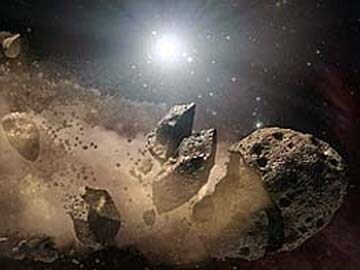
Washington:
NASA is zeroing in on the asteroids it wants to capture, haul near the moon and have astronauts visit.
Officials on Thursday described a prime candidate: A tiny asteroid that whizzed about 7,600 miles (12,250 kilometers) above Earth in 2011.
At 20 feet (6 metres) long, it is "the size of a delivery truck; we might actually be able to put this asteroid in a garage," said Northern Arizona University astronomer Michael Mommert, who studied the rock, which goes by the inelegant name of 2011 MD.
That asteroid also could be a pile of smaller rocks that fly together in formation.
NASA's plan is to grab an asteroid with a giant claw or capture it with a giant inflatable bag. The asteroid would be parked above the moon, with astronauts exploring in a later mission.
NASA executive Lindley Johnson said there will eventually be about 10 possible rocks for capture in the early 2020s, but they may not all be small asteroids.
There's a second option NASA is considering: Sending a spacecraft to a much larger asteroid, using a claw to pluck off a boulder that's less than 30 feet (9 metres) and taking it near to the moon.
NASA will decide which option to pursue by the end of the year, said Michele Gates, programme director for the asteroid mission.
So far, NASA has three candidates for each option. But Johnson said he expects more to be identified. NASA doesn't have to choose its final target until a year before launch, which could be as early as 2019.
But Thursday's press conference highlighted 2011 MD. That's because when it came close to Earth in 2011, it was examined by telescopes on Earth and the Spitzer Space Telescope. Details of the asteroid were published in an astronomy journal Thursday.
Those observations showed that it probably weighs around 100 tons but is so porous that about two-thirds is empty space and only one-third is rock, Mommert said.
NASA has touted the asteroid mission since the space shuttle fleet retired as a stepping stone to send crews to Mars.
The robotic cost of the mission would be about $1.2 billion, Gates said. But there's no good estimate yet for the astronaut part, which includes using a yet-to-be-built giant rocket, officials said.
Officials on Thursday described a prime candidate: A tiny asteroid that whizzed about 7,600 miles (12,250 kilometers) above Earth in 2011.
At 20 feet (6 metres) long, it is "the size of a delivery truck; we might actually be able to put this asteroid in a garage," said Northern Arizona University astronomer Michael Mommert, who studied the rock, which goes by the inelegant name of 2011 MD.
That asteroid also could be a pile of smaller rocks that fly together in formation.
NASA's plan is to grab an asteroid with a giant claw or capture it with a giant inflatable bag. The asteroid would be parked above the moon, with astronauts exploring in a later mission.
NASA executive Lindley Johnson said there will eventually be about 10 possible rocks for capture in the early 2020s, but they may not all be small asteroids.
There's a second option NASA is considering: Sending a spacecraft to a much larger asteroid, using a claw to pluck off a boulder that's less than 30 feet (9 metres) and taking it near to the moon.
NASA will decide which option to pursue by the end of the year, said Michele Gates, programme director for the asteroid mission.
So far, NASA has three candidates for each option. But Johnson said he expects more to be identified. NASA doesn't have to choose its final target until a year before launch, which could be as early as 2019.
But Thursday's press conference highlighted 2011 MD. That's because when it came close to Earth in 2011, it was examined by telescopes on Earth and the Spitzer Space Telescope. Details of the asteroid were published in an astronomy journal Thursday.
Those observations showed that it probably weighs around 100 tons but is so porous that about two-thirds is empty space and only one-third is rock, Mommert said.
NASA has touted the asteroid mission since the space shuttle fleet retired as a stepping stone to send crews to Mars.
The robotic cost of the mission would be about $1.2 billion, Gates said. But there's no good estimate yet for the astronaut part, which includes using a yet-to-be-built giant rocket, officials said.
Track Latest News Live on NDTV.com and get news updates from India and around the world

